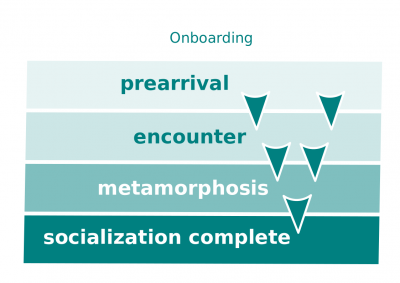Difference between revisions of "Onboarding"
| Line 1: | Line 1: | ||
| − | [[File:Socialization.png|400px|thumb|right|[[Onboarding]]]][[Onboarding]] | + | [[File:Socialization.png|400px|thumb|right|[[Onboarding]]]][[Onboarding]] is the process through which: |
| − | *A new employee acquires the necessary competence and credentials in order to become a productive organizational member and insider; | + | *A new employee acquires the necessary competence and credentials in order to become a productive organizational member and insider. This process is also known as [[organizational socialization]], [[socialization process]], or, simply, [[socialization]]; |
*An employer settles a new employee in a particular position. | *An employer settles a new employee in a particular position. | ||
''Onboarding'' can also described as the mechanism of integrating a new [[employee]] into the [[enterprise]] and its [[culture]]. | ''Onboarding'' can also described as the mechanism of integrating a new [[employee]] into the [[enterprise]] and its [[culture]]. | ||
Revision as of 12:39, 18 December 2019
Onboarding is the process through which:
- A new employee acquires the necessary competence and credentials in order to become a productive organizational member and insider. This process is also known as organizational socialization, socialization process, or, simply, socialization;
- An employer settles a new employee in a particular position.
Onboarding can also described as the mechanism of integrating a new employee into the enterprise and its culture.
Definitions
According to Organizational Behavior by Robbins and Judge (17th edition),
- Socialization. A process that adapts employees to the organization's culture.
Stages
- Prearrival stage. The period of learning in the socialization process that occurs before a new employee joins the organization.
- Encounter stage. The stage in the socialization process in which a new employee sees what the organization is really like and confronts the possibility that expectations and reality may diverge.
- Metamorphosis stage. The stage in the socialization process in which a new employee changes and adjusts to the job, work group, and organization.
